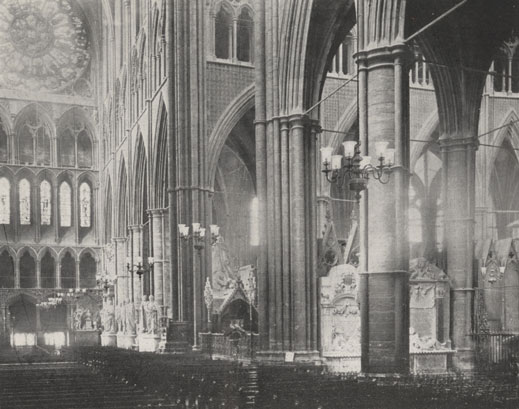With the impending wedding of Prince Harry and Meghan Markle on 19 May 2018 at Windsor Castle, we thought it would be an appropriate time to revisit one of the more unusual items in the IET Archive collections relating to royal celebrations. The item shown above is a financial ledger which has the title on the cover, ‘Westminster Abbey: Coronation Account, 1911, GV: S W M’. S W M stands for Mr S W Maddick, an individual who was transferred from H M Offices of Works to supervise and design the electric lighting for Westminster Abbey for the Coronation of King George V and Queen Mary in June 1911.
Electric lighting had been installed for the first time in Westminster Abbey temporarily in 1902 for the Coronation of King Edward VII, but no decision was made about its permanent retention. Electric lighting was again introduced, initially on a temporary basis, for the 1911 Coronation, but after the ceremony, the supply cable and main fuse boards were not withdrawn and these became part of a permanent installation.
Maddick’s handwritten ledger begins on 25 February 1911, and provides full details of all the electrical and related works carried out and their costs including details of staff wages paid, the names of companies supplying equipment and labour, details of equipment and materials supplied, and meter readings for electricity consumed. The ledger does not stop after June 1911 but instead continues with regular entries up until 3 May 1913 as Maddick continued to supervise the permanent installation of electric lighting following the Coronation. A typical page from the ledger is shown below.

An account of the installation of the electric lighting in Westminster Abbey was printed in The Electrician, 1 August 1913, and a 6-page reprint of that article is enclosed within the ledger.
The Electric Lighting of Westminster Abbey – an Account in The Electrician, 1913
The article in The Electrician mentions that “a supply of continuous current is obtained from the Westminster Electric Supply Corporation at 200 volts for the lighting and at 400 volts for the organ blowers”. In addition to full details of the electrical fixtures and fittings, the article included 4 photographs of the electrical installations, and these are reproduced below, together with the accompanying text.
Figure 1 – transept lighting

“The Flemish design from which most of the electroliers [electric chandeliers] are adopted is illustrated in figure 1, which shows the single row of fittings in the transept. Their suspension is effected throughout by means of a 6 inch channel steel girder fastened to the roof timbers by cast-iron brackets, from which the electrolier, weighing about 30 pounds, is suspended by a steel cable surrounded by the leads of the fitting.”
Figure 2 – girder suspension of electroliers and arrangement of conduit

“Figure 2 shows the attachment of the suspension cable to the u-bolt of the girder, also an iron cover that is placed over the two porcelain fuse boxes where connection is made to the leads forming an enclosed box with the sides of the channel girder.”
Figure 3 – diffusing type of tubular desk lamp for choir stalls

“Figure 3 shows the tubular fitting with serrated opening. It will be noticed that no leading-in wires appear on the outside…….., no fittings that would disfigure the valuable carving of the stalls could be used”.
Figure 4 – lamps in Henry VII Chapel

“The flat surfaces of the newel posts of each row of stalls, probably designed in their time for candlesticks to be placed there, have been provided with bronze bayonet-catch rings, into each of which slips a bronze-finished standard of a suitable pattern carrying one lamp. Figure 4 shows one of these standards with the flexible lead detached. It will be noticed that the only permanent fixing is the flat bayonet catch ring which in no way disfigures the newel post.”
For anyone wishing to consult the 1911 coronation electric lighting accounts (archive reference SC MSS 296) they can be viewed at the IET Archives, by appointment. A digital version of the account in The Electrician is also available by request.

Leave a comment